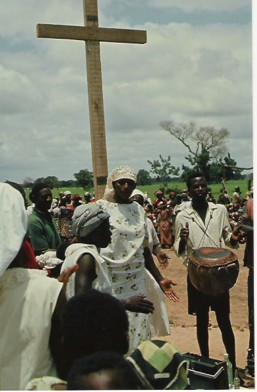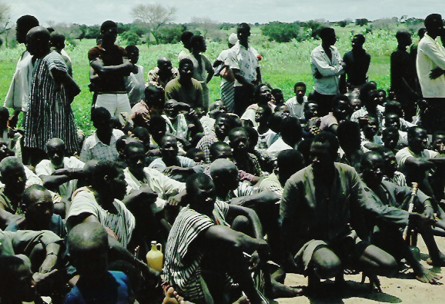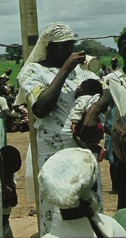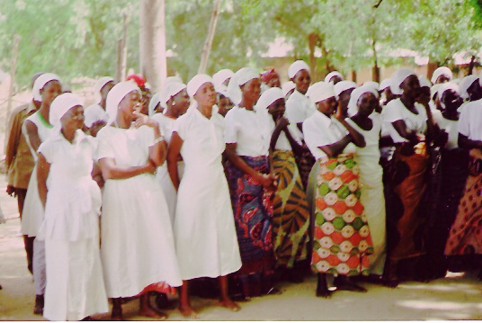Franz Kröger
A Visit to a Meeting of Akawuruk and
Her Adherents
(based on diary notes)
 For Sunday 30th July, 1978 I planned a visit to the new charismatic movement, led by
Akawuruk (or Kawuru), a woman from Kalijiisa married to Abavang, a man from Chana-Gugoro (Kasena area). On my motor-bike, it was very difficult to force my way through the
crowds of people filling the whole track from Sandema Market to Kalijiisa. Many of these
people were carrying pots or bottles for Akawuruk’s water to heal their diseases.
For Sunday 30th July, 1978 I planned a visit to the new charismatic movement, led by
Akawuruk (or Kawuru), a woman from Kalijiisa married to Abavang, a man from Chana-Gugoro (Kasena area). On my motor-bike, it was very difficult to force my way through the
crowds of people filling the whole track from Sandema Market to Kalijiisa. Many of these
people were carrying pots or bottles for Akawuruk’s water to heal their diseases.
On a clear site near Akawuruk’s father’s compound Adiok Yeri, I could see an oversized cross
towering above an immense crowd of people. Later I tried to estimate their number: around
1500 visitors! Among them I found many old friends from Kalijiisa-Yongsa, where I had started
my anthropological research: Nearly all the elders and even the teng-nyono (earth-priest) were
sitting “under the cross”. My Kalijiisa assistant Azangbiok and I greeted Mrs Akawuruk. She
welcomed us kindly and allowed us to take photos of whatever we liked.
 It was easy to recognize the spatial arrangement of the ceremonial site and the people. In the
centre of an inner circle, marked by stones, was the big wooden cross, in front of it Akawuruk’s
chair that she even offered to me during our short talk. In the “middle circle” I could see many
people, most of them women, dressed in long white robes. These people were her closest
adherents. Accompanied by a group of musicians with a calabash drum (gori), an hourglass-drum (gunggong) and basketry rattles (san-yaala) they were singing, dancing and moving
around the inner circle. These dances resembled the duelinka-dances of traditional funerals,
when people were dancing around the funerary compound. A dozen people, not all of them
dressed in white, were lying on the ground in trance. Obsessed by “the spirit” (sunsum in
Kasem) they were trembling, crying and rolling about. Some visitors rushed up to them to get
some sand on which an obsessed woman had been lying. It was supposed to have a curative
effect. Among the people of the middle circle I found my friend and second Kalijiisa assistant
Sebastian, a fervent adherent of Akawuruk. Here, he was responsible for maintaining order and
making sure that nobody got injured. Only rarely did he interrupt the ecstatic state of the person
lying on the ground, e.g. (as he told me later) of a mother, should her small child be crying for
her. He wiped her face with his right hand, shook her a little and helped her to get up.
It was easy to recognize the spatial arrangement of the ceremonial site and the people. In the
centre of an inner circle, marked by stones, was the big wooden cross, in front of it Akawuruk’s
chair that she even offered to me during our short talk. In the “middle circle” I could see many
people, most of them women, dressed in long white robes. These people were her closest
adherents. Accompanied by a group of musicians with a calabash drum (gori), an hourglass-drum (gunggong) and basketry rattles (san-yaala) they were singing, dancing and moving
around the inner circle. These dances resembled the duelinka-dances of traditional funerals,
when people were dancing around the funerary compound. A dozen people, not all of them
dressed in white, were lying on the ground in trance. Obsessed by “the spirit” (sunsum in
Kasem) they were trembling, crying and rolling about. Some visitors rushed up to them to get
some sand on which an obsessed woman had been lying. It was supposed to have a curative
effect. Among the people of the middle circle I found my friend and second Kalijiisa assistant
Sebastian, a fervent adherent of Akawuruk. Here, he was responsible for maintaining order and
making sure that nobody got injured. Only rarely did he interrupt the ecstatic state of the person
lying on the ground, e.g. (as he told me later) of a mother, should her small child be crying for
her. He wiped her face with his right hand, shook her a little and helped her to get up.
The outer circle of the meeting consisted of visitors, most of them seated. I could see from their
eyes that some of them were enthusiastic about what they saw while others seemed to be more
sceptical.
After some time Akawuruk gave her sermon. She told the listeners about her own conversion. Living in Nkakaw (Southern Ghana) she had been very sick, until she was healed by
a man in a long white robe.
After the sermon many people came to Akawuruk in the inner circle with their bottles and
ceramic containers. Akawuruk prayed over the water to make it curative. At home, the sick
people drank it and mixed part of it into their bath-water. Some people, especially those who
had been healed from disease by Akawuruk in the past, gave money and/or fibres (for a new
sunshade). Other people tried to touch the big wooden cross or rub their (sick?) babies against
it.
 In the late afternoon I went home, although the meeting went on until late in the night.
In the late afternoon I went home, although the meeting went on until late in the night.
On the next day, before starting our work on the Buli-English Dictionary, I had a talk with
Sebastian, Akawuruk’s as well as my own assistant. He told me that Akawuruk and her
adherents acknowledged the existence of the spirits and divine powers of
traditional religion, but most of them were classed as bad and harmful to humans. Together with
a group of young men, she had tried to drive tanggbana (earth spirits) out of their shrines
(sacred trees, rocks etc.) the night before. Ancestor worship is not rejected, if the ancestor lived
a morally good life. Several other informants confirmed that she even prescribes sacrifices to
“good” ancestors as a remedy against diseases and other problems.
lived
a morally good life. Several other informants confirmed that she even prescribes sacrifices to
“good” ancestors as a remedy against diseases and other problems.
The most dubious aspect of the “spiritualists” (as they are called by other Bulsa) concerns their
attitude towards witches (Buli: sakpaksa, Kasem: chera). It has been acknowledged even by
some of Akawuruk’s enemies that she and her followers can recognize and expose
witches/wizards when confronted with them. People in trance often mention the names of
witches who, if present, sometimes confess their guilt immediately. Aggressive outrages
against witches were reported by several informants, but I myself could neither prove nor
disapprove them.
-----
In July 1979, when I visited Buluk again, Akawuruk’s movement had a further station at Chana,
where her husband lived and (later) also in Wiaga, but nevertheless it had lost a lot of its
influence. According to Sebastian, who in 1979 worked only occasionally for Mrs Akawuruk,
there were only about 40 members of her movement in Kalijiisa.

 For Sunday 30th July, 1978 I planned a visit to the new charismatic movement, led by
Akawuruk (or Kawuru), a woman from Kalijiisa married to Abavang, a man from Chana-Gugoro (Kasena area). On my motor-bike, it was very difficult to force my way through the
crowds of people filling the whole track from Sandema Market to Kalijiisa. Many of these
people were carrying pots or bottles for Akawuruk’s water to heal their diseases.
For Sunday 30th July, 1978 I planned a visit to the new charismatic movement, led by
Akawuruk (or Kawuru), a woman from Kalijiisa married to Abavang, a man from Chana-Gugoro (Kasena area). On my motor-bike, it was very difficult to force my way through the
crowds of people filling the whole track from Sandema Market to Kalijiisa. Many of these
people were carrying pots or bottles for Akawuruk’s water to heal their diseases.  It was easy to recognize the spatial arrangement of the ceremonial site and the people. In the
centre of an inner circle, marked by stones, was the big wooden cross, in front of it Akawuruk’s
chair that she even offered to me during our short talk. In the “middle circle” I could see many
people, most of them women, dressed in long white robes. These people were her closest
adherents. Accompanied by a group of musicians with a calabash drum (gori), an hourglass-drum (gunggong) and basketry rattles (san-yaala) they were singing, dancing and moving
around the inner circle. These dances resembled the duelinka-dances of traditional funerals,
when people were dancing around the funerary compound. A dozen people, not all of them
dressed in white, were lying on the ground in trance. Obsessed by “the spirit” (sunsum in
Kasem) they were trembling, crying and rolling about. Some visitors rushed up to them to get
some sand on which an obsessed woman had been lying. It was supposed to have a curative
effect. Among the people of the middle circle I found my friend and second Kalijiisa assistant
Sebastian, a fervent adherent of Akawuruk. Here, he was responsible for maintaining order and
making sure that nobody got injured. Only rarely did he interrupt the ecstatic state of the person
lying on the ground, e.g. (as he told me later) of a mother, should her small child be crying for
her. He wiped her face with his right hand, shook her a little and helped her to get up.
It was easy to recognize the spatial arrangement of the ceremonial site and the people. In the
centre of an inner circle, marked by stones, was the big wooden cross, in front of it Akawuruk’s
chair that she even offered to me during our short talk. In the “middle circle” I could see many
people, most of them women, dressed in long white robes. These people were her closest
adherents. Accompanied by a group of musicians with a calabash drum (gori), an hourglass-drum (gunggong) and basketry rattles (san-yaala) they were singing, dancing and moving
around the inner circle. These dances resembled the duelinka-dances of traditional funerals,
when people were dancing around the funerary compound. A dozen people, not all of them
dressed in white, were lying on the ground in trance. Obsessed by “the spirit” (sunsum in
Kasem) they were trembling, crying and rolling about. Some visitors rushed up to them to get
some sand on which an obsessed woman had been lying. It was supposed to have a curative
effect. Among the people of the middle circle I found my friend and second Kalijiisa assistant
Sebastian, a fervent adherent of Akawuruk. Here, he was responsible for maintaining order and
making sure that nobody got injured. Only rarely did he interrupt the ecstatic state of the person
lying on the ground, e.g. (as he told me later) of a mother, should her small child be crying for
her. He wiped her face with his right hand, shook her a little and helped her to get up.
 In the late afternoon I went home, although the meeting went on until late in the night.
In the late afternoon I went home, although the meeting went on until late in the night. lived
a morally good life. Several other informants confirmed that she even prescribes sacrifices to
“good” ancestors as a remedy against diseases and other problems.
lived
a morally good life. Several other informants confirmed that she even prescribes sacrifices to
“good” ancestors as a remedy against diseases and other problems.